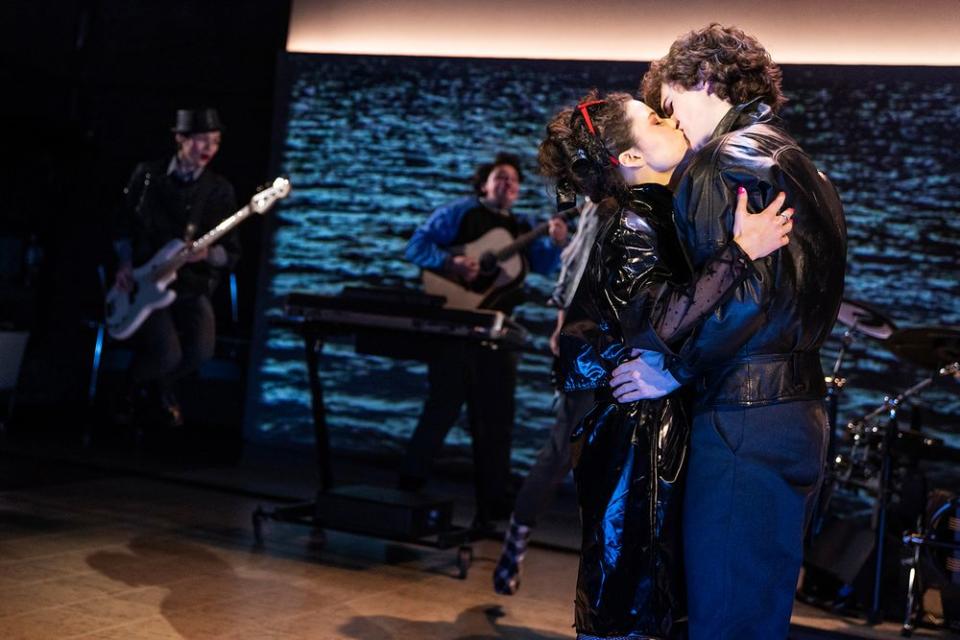Sing Street's musical charm is even more infectious on stage: Review
There are both challenges and opportunities in bringing Sing Street to the stage. John Carney’s 2016 film about music videos and young love in ‘80s Dublin is much newer than other movies currently getting adapted into musicals (such as Almost Famous). The advantage here is that Sing Street isn’t as enshrined in people’s minds as the classics, opening up room to expand the script, tweak characterizations, and present the songs in new ways. The people behind the Sing Street musical, running in a limited performance at the New York Theatre Workshop from Dec. 16-Jan. 26, do use this opportunity to tinker in the margins, but ultimately keep the story focused on the energetic songs and the central romance.
Like the movie, the Sing Street musical is set in 1982 Dublin, where economic stagnation clouds the horizon and makes it hard for bright young kids to imagine a better future for themselves. Austerity both in government and at home forces Conor Lawlor (Brenock O’Connor) to move from a private school to a free school run by the Christian Brothers. The school is run by Brother Baxter (Martin Moran), who attempts to make hard days even harder by stamping out his students’ individual expression and creativity. Paradoxically, this just inspires Conor to pursue music with even greater gusto. Inspired by contemporary bands like Duran Duran and The Cure, instructed by his older brother Brendan (Gus Halper), and smitten by the lovely Raphina (Zara Devlin), Conor forms a band with kids at school in order to actually get something out of life.
Unlike the movie, of course, this Sing Street musical doesn’t have access to the sights and sounds of Dublin, but its staging is quite inventive. A picture of the sea is used as the backdrop, which both casts a characteristic gray shroud over everything, and also foreshadows Conor and Raphina’s ultimate decision to run away. For those who remember one of the film’s best scenes (when Raphina jumps into the sea in the midst of a music video shoot, both to make it more visually interesting and to see if Conor will follow her), rest assured the play makes it its own: The actors throw buckets of water on each other instead. “Your mascara’s running,” Conor points out. “So’s yours,” Raphina counters. Then they finally come together for a first kiss, and Act 1 ends in glory.

The Sing Street songs, composed by Gary Clark and others, should not be as good as they are. Nevertheless, tracks like “Up” and “Girls” manage to evoke the best sounds of the ‘80s while also sounding like a lovestruck high schooler could have believably written them. The musical presents them beautifully, often in non-literal fashion to great effect. “Up,” an ode to how great it feels to fall in love, is performed by Conor and the band. But while they play, Raphina is listening to the tape Conor gave her on her headphones, dancing and weaving between them and coming to grips with her own feelings. “Drive It Like You Stole It” allows the boys to vogue in their own school hallways, sticking it to Brother Baxter while clad in makeup and colorful rock costumes. When one boy gets nervous about sporting makeup in public, a bandmate assuages him: “It’s the evolution of man!”
Unfortunately, since every song is written and performed by Conor and the band, some characters get left out of the musical portion. Raphina joins the band to sing on some songs but never gets a showcase of her own. Matching the performance of “Girls” to a family fight at Conor and Brendan’s home allows their architecture student sister Anne’s (Skyler Volpe)’s frustrated slamming of books to become its own additional percussive instrument. It’s not enough to fully incorporate them into the music of Sing Street, but it’s a start.
There is a similar broadening of the plot and characterization. The book by Enda Walsh looks a little harder at the physical abuse suffered by many characters in Ireland’s Catholic culture even more than the movie did, which adds some sympathy to Brother Baxter and some tragic darkness to Raphina. The mother of one of Conor’s bandmates becomes more of a presence, though to what end is a little unclear. Ultimately, Sing Street is driven by the power of its songs and the central romance between Conor and Raphina. If the show wants to be even bigger, it probably needs to go all the way and incorporate another song or two to maximize new plot/character developments. But even now, it’s a joy just to be swept along that beautiful sea. B+
Related content:

